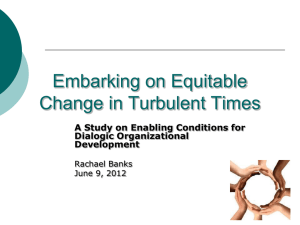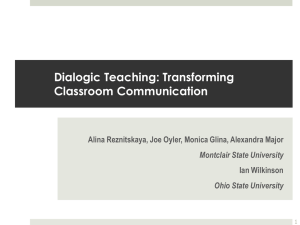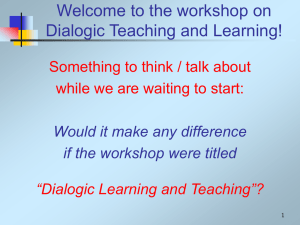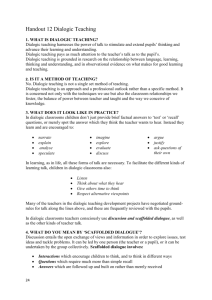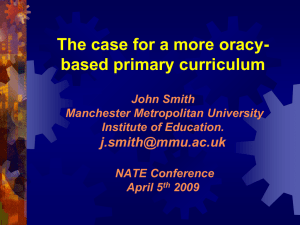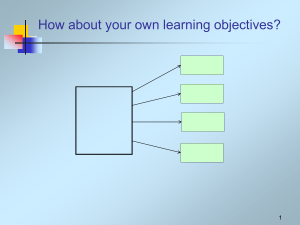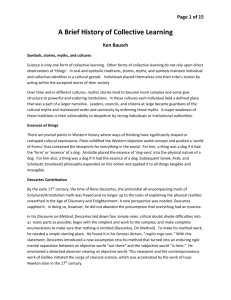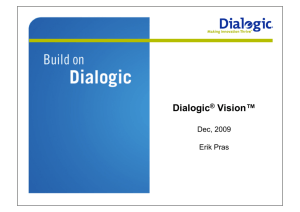diagnostic dialogic
advertisement
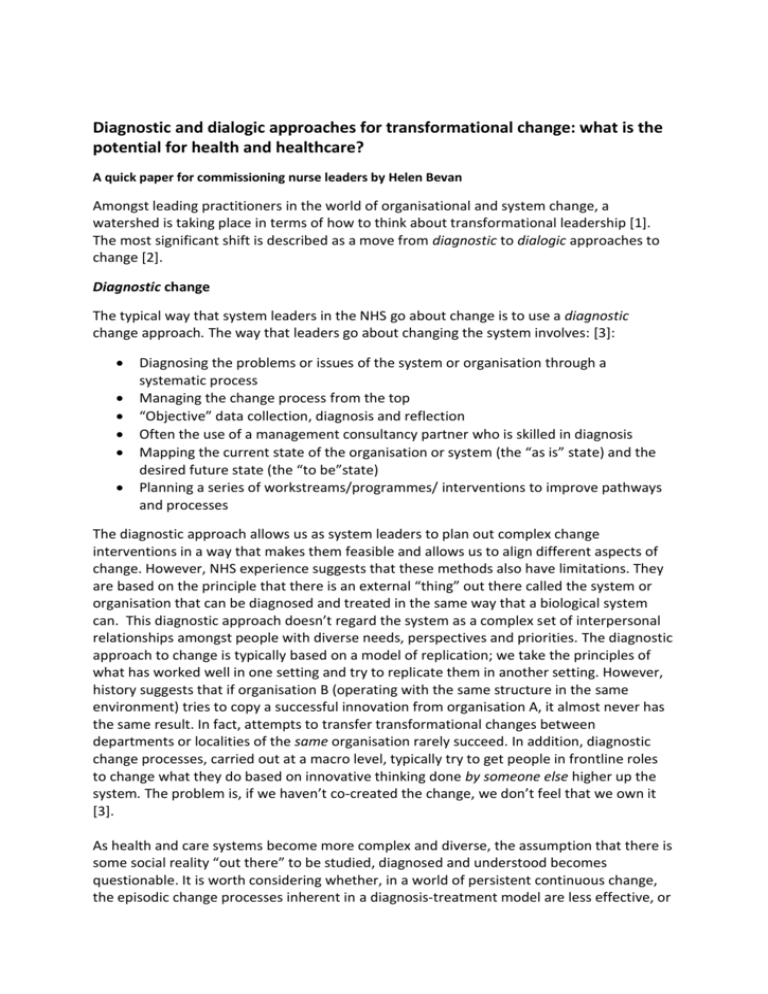
Diagnostic and dialogic approaches for transformational change: what is the potential for health and healthcare? A quick paper for commissioning nurse leaders by Helen Bevan Amongst leading practitioners in the world of organisational and system change, a watershed is taking place in terms of how to think about transformational leadership [1]. The most significant shift is described as a move from diagnostic to dialogic approaches to change [2]. Diagnostic change The typical way that system leaders in the NHS go about change is to use a diagnostic change approach. The way that leaders go about changing the system involves: [3]: Diagnosing the problems or issues of the system or organisation through a systematic process Managing the change process from the top “Objective” data collection, diagnosis and reflection Often the use of a management consultancy partner who is skilled in diagnosis Mapping the current state of the organisation or system (the “as is” state) and the desired future state (the “to be”state) Planning a series of workstreams/programmes/ interventions to improve pathways and processes The diagnostic approach allows us as system leaders to plan out complex change interventions in a way that makes them feasible and allows us to align different aspects of change. However, NHS experience suggests that these methods also have limitations. They are based on the principle that there is an external “thing” out there called the system or organisation that can be diagnosed and treated in the same way that a biological system can. This diagnostic approach doesn’t regard the system as a complex set of interpersonal relationships amongst people with diverse needs, perspectives and priorities. The diagnostic approach to change is typically based on a model of replication; we take the principles of what has worked well in one setting and try to replicate them in another setting. However, history suggests that if organisation B (operating with the same structure in the same environment) tries to copy a successful innovation from organisation A, it almost never has the same result. In fact, attempts to transfer transformational changes between departments or localities of the same organisation rarely succeed. In addition, diagnostic change processes, carried out at a macro level, typically try to get people in frontline roles to change what they do based on innovative thinking done by someone else higher up the system. The problem is, if we haven’t co-created the change, we don’t feel that we own it [3]. As health and care systems become more complex and diverse, the assumption that there is some social reality “out there” to be studied, diagnosed and understood becomes questionable. It is worth considering whether, in a world of persistent continuous change, the episodic change processes inherent in a diagnosis-treatment model are less effective, or that they take too long to get to a prescription, and the system might have already changed too much for it to be valid by the time we get round to implementing the changes. It may be that, given the current challenges of the health and care system, we have reached a point in time when system leaders need more than incremental, controlled change processes. Dialogic change From a dialogic perspective, change results from transformational conversations; it is about “changing the discussions” that shape everyday thinking and behaviour by: involving more and different people in the change discussions altering how and which people engage with each other by stimulating different perspectives to shape how people think about things Therefore instead of (or as well as) change driven by diagnosing how to objectively align or re-align different elements of the organisation or system (strategies, structures, people practices, etc.), the dialogic perspective invites us to consider how to induce new ways of thinking by altering the ongoing organisational conversations that continuously create, recreate, and frame understanding and action. In dialogical approaches, the focus is on encouraging new thinking in the people who are the targets of change themselves —new thinking that is not prescribed by some expert or management consultant partner, but that emerges individually and collectively from going through the change process. The creation of new perspectives, images, stories, texts, narratives, and other socially constructed realities will impact on how people think and make sense of things — and that, in turn, will impact how they act. From the dialogic point of view, the reason an innovation works differently in organisations A and B is that people make different meanings of the innovation in those different organisations. As a result of exposure to dialogic ideas, an increasing number of system leaders with transformational aspirations are turning away from a dependence on diagnostic methods that treat organisations as if they were biological systems in their change methods, even if they still talk like they are. These leaders assume that organisations are socially co-constructed realities and, because of this, that there is nothing inherently “real” about how we organise for health and care, no ultimate truth about organisations to be discovered, and no model of the right way to organise independent of the people who make up the specific organisation or system. There are a range of dialogical approaches. Peggy Holman[3] suggests three aspects: 1. Create the conditions for transformational conversations by asking questions that are focussed on future possibilities, by inviting diversity into the system, and by being welcoming 2. Create opportunities for everyone to express their views, spot opportunities and build on each other’s ideas 3. Create ways for people to reflect together to find meaning, understanding and shared purpose in the change The two approaches are contrasted below: Diagnostic The organisation as a “thing” that exists in its own right and that can be diagnosed and changed Convergent & reflective Dialogic People in the act of organising for change (making meaning and coordinating action) Divergent & projective Leader imparts wisdom, sets direction and reinforces messages Univocal (fixing on a clear problem) Leader generates opportunities for transformational conversations and ensures everyone’s voice is heard Resistance as an inevitable consequence of a complex change process (based on diversity) that should be embraced and worked with Working in and with the everyday communicative actions and conversations that constitute the way people organise themselves. Plurivocal (embracing multiple solutions) Concrete (knowable and tangible) Abstract (uncertain and intangible) Resistance as a problem to be solved Discrete “one off” change initiatives and situations Expert with an answer Solving problems Identifying the best solutions Mandate from the top Source: based on sources 1-5 below Difference that makes a difference Exposing paradox Collective sensemaking Influence from everywhere Conclusions The use of dialogic principles is at an early stage in the NHS. We believe that the potential is significant and that commissioning nurse leaders can be the pioneers in testing and using these principles in their everyday practice as transformational leaders. Of course, the future scenario won’t be an “either/or” with regard to diagnostic and dialogic approaches. Neither do we wish to create the impression that diagnostic is “bad and dialogic is “good”. Both have their role in future systems leadership and both are underpinned by a leadership focus on: strong NHS values and our desire to provide better outcomes for patients and the public wanting to encourage and facilitate awareness of the system (albeit through very different methods) building capability for change and developing the system[5] Diagnostic approaches will continue to dominate but if we can create leadership capability in dialogic approaches, we can foster the conditions for positive outcomes from our transformation efforts References 1. Katherine Farquhar NTL’s “Conference on the New OD”: Turning Thought into Action http://bit.ly/If4Nch 2. Gervase R. Bushe Dialogic OD Turning Away from Diagnosis http://bit.ly/1cpBk8S 3. Keith W. Ray and Joan Goppelt Dialogic OD in Day to Day Complexity http://bit.ly/18E2jyh 4. Peggy Holman, A Call to Engage: Realizing the Potential of Dialogic Organization Development http://bit.ly/IfwdP7 5. Gervase R. Bushe, Robert J. Marshak (2013) Revisioning Organization Development Diagnostic and Dialogic Premises and Patterns of Practice http://bit.ly/1b28xUJ Also see: Peggy Holman, Change Your Story, Change Your Organization http://seapointcenter.com/change-yourstory/?utm_source=hootsuite&utm_campaign=hootsuite

